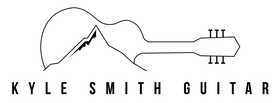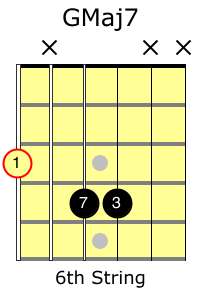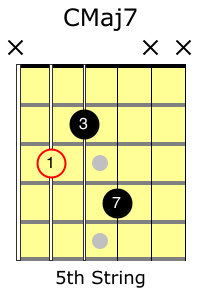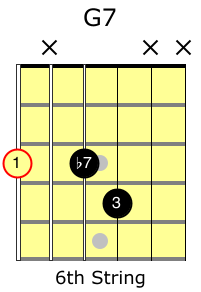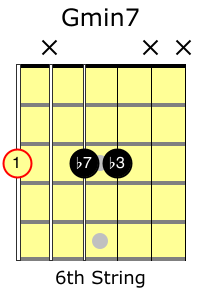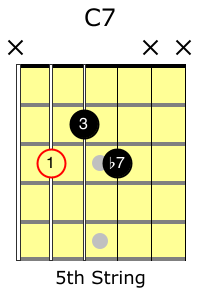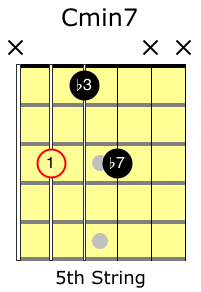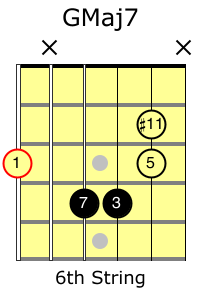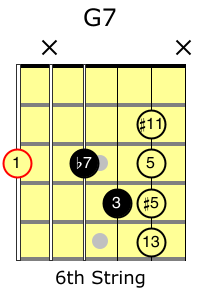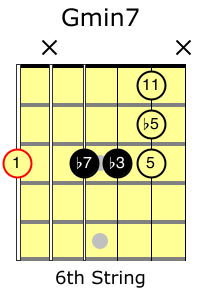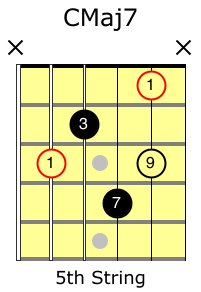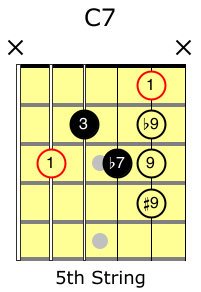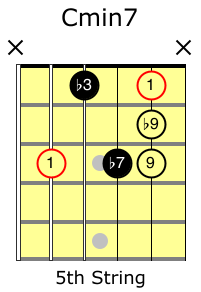 At some point in your jazz guitar playing career, someone is going to ask you to use something called "rootless voicings" for your chords. This is especially true if you're playing in a jazz ensemble or small group at the high school or college level. (If you're playing professionally, you probably already know what rootless voicings are, how to use them, and when to use them in your playing.) The theory here is that if you're playing the root as a part of your chord, it's an unnecessary note because the bass player is playing the root as a part of their bass line. While I don't 100% agree with this idea as a fundamental rule, it's still important for you to learn how to play these rootless chords. You want to be able to do what your director/bandleader/etc asks you to do - it's your job as the guitar player, and they are likely hearing things out front that you are not hearing from your seat by the amplifier. By dropping off the root from your basic jazz guitar chords you open up new possibilities for color, and free up your hands for simpler "grips" on your chords. Even when you're not asked to, experiment with using these chords to see what they sound like in a playing situation. Eventually, you want to be able to decide whether or not to include the root at the bottom of your chord based on the situation (song, style, band, soloist preferences). What You Need To Know FirstTo get the most out of this jazz guitar lesson, you want to be familiar with the basic jazz guitar voicings. The later section of this lesson will also cover rootless chords with color tones, so check out the lesson on adding one color tone as well. Knowing the notes on the 5th and 6th strings is a huge help. Use the fretboard map below if you need it. Why Learn Rootless Chord Voicings?Learning rootless chord voicings can help you:
Practicing Rootless Jazz Guitar ChordsAt first, I would recommend practicing these chords around a cycle: Choose one rootless chord shape, and then play it around the cycle of 4ths or the cycle of 5ths. After you've worked out both the 6th and 5th string forms, try alternating:
In the end, your best bet is to put these shapes to work in the songs you are playing as soon as possible. If you can remember the shapes, start using them in your music - whether that means playing a jazz band, picking tunes out of the real book, or something else. The more you play them, the easier they will get! How To Build Rootless Jazz Guitar ChordsBuilding rootless jazz guitar chords is pretty simple, really: Take one of the basic jazz guitar chords from this earlier lesson, and don't play the root. It's really that easy, at least on the surface. To start, you can even keep your finger on the root note, but avoid playing it. That's a pretty basic way of doing it, but it can work really well to get started. The problem is that if your finger is on the root, you're going to want to play it. Another issue is that you're tying up a finger that could otherwise be playing notes you actually DO want to play. We're going to go a little deeper with this and look at something I call implied root chords. Implied Root Chord ShapesGuitar is a visual instrument, so it helps to have visual cues you can use. If you're going to dive in to playing rootless jazz guitar chords, you still need some kind of reference point in order to know that you're playing the right chord. The implied root is a concept designed to help you with that. The implied root is shown as an open circle on your chord diagrams below - meaning that you don't play it, but you still use it to find your place. The key here is to only play the filled in notes, but still reference the root location to make sure you're on the correct chord. As you can see, you're left with playing the 3rd and 7th of each chord - known as the Guide Tones. See if you can keep track of your root while only putting your fingers on the guide tones of each chord. With practice, this get's easier and easier to play - seeing the root on the fretboard, but only playing the 3rd and 7th. Implied Roots - Basic Jazz Guitar Chords6th String Form5th String FormPlay with these chords around the cycle of 4ths or 5ths, or through a tune you already play from the real book your jazz band music, or other sources. This will be fairly easy to do if you're already comfortable with the basic 3 note jazz guitar chords. Cycle of 4ths:C F Bb Eb Ab Db Gb B E A D G Cycle of 5ths:G D A E B F# C# G# D# A# F C Implied Roots - Adding One Color Tone6th String Form5th String FormAgain, these will be familiar to you if you're already using the basic jazz chords with 1 color tone. You'll find that some of these color tones are easier to reach now that you're not using a finger to play the root on the 6th or 5th strings. This will give you a lot of flexibility for creating nice melodies on top of your chords, and supporting soloists in a group. Follow the practice advice above, and do your best to play these through songs as soon as possible - it's the best way to really get these under your fingers. Thoughts On Rootless VoicingsWhether or not you include the root on the bottom of your chord really depends on the situation you are in. If your bandleader or some other teacher asks you to play rootless voicings, do it. Keep your ears open - try to figure out why rootless voicings were necessary or the best choice in this case. If I'm playing by myself, especially on the first run through a tune, I'll absolutely play the root. Every time. But after that I'll usually play around with different voicings and chord shapes to get different sounds. If I'm playing in a small group with a bass player, I will almost always play the rootless versions of chords - unless I need the root on top as a melody note. If I'm playing in a big band, it really depends on the situation, and what the band leader wants. If I'm playing Count Basie music, or something in a similar style, my go-to is the basic 3 note jazz guitar chords, with the root on the bottom. The more experiences you get playing different kinds of songs and in different types of groups will help you understand when it's important to go rootless, and when it isn't. Ditching the root can give you more freedom with the colors you add to your chords, and help you become more responsive to soloists. This is especially true when you are the only one playing chords - rootless jazz guitar chords can give you a lot of freedom to get creative in your accompaniment. Keep practicing - the more you work on your comping and chord skills, the more you'll understand what sounds you want to include in a given playing situation.
As much as we'd like it to be, it's not an exact science -you have to use your ears, experiment, and get a feel for what works. Remember - the more you play with these, the easier it will get to use rootless voicings in your guitar playing. Keep playing, and let me know how it goes!
0 Comments
Your comment will be posted after it is approved.
Leave a Reply. |
